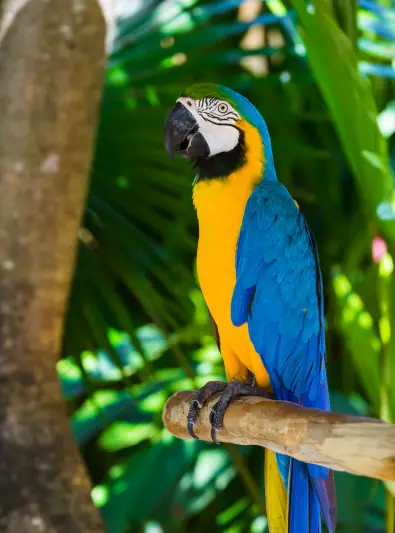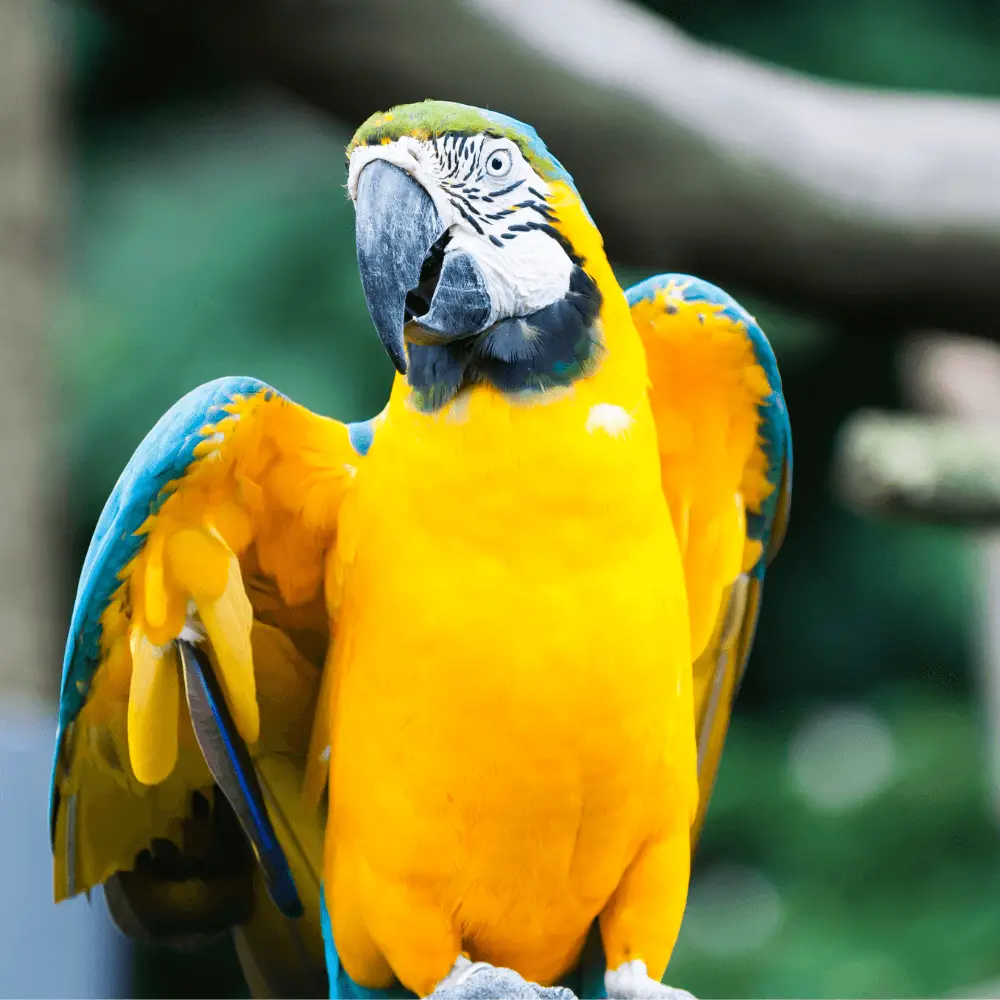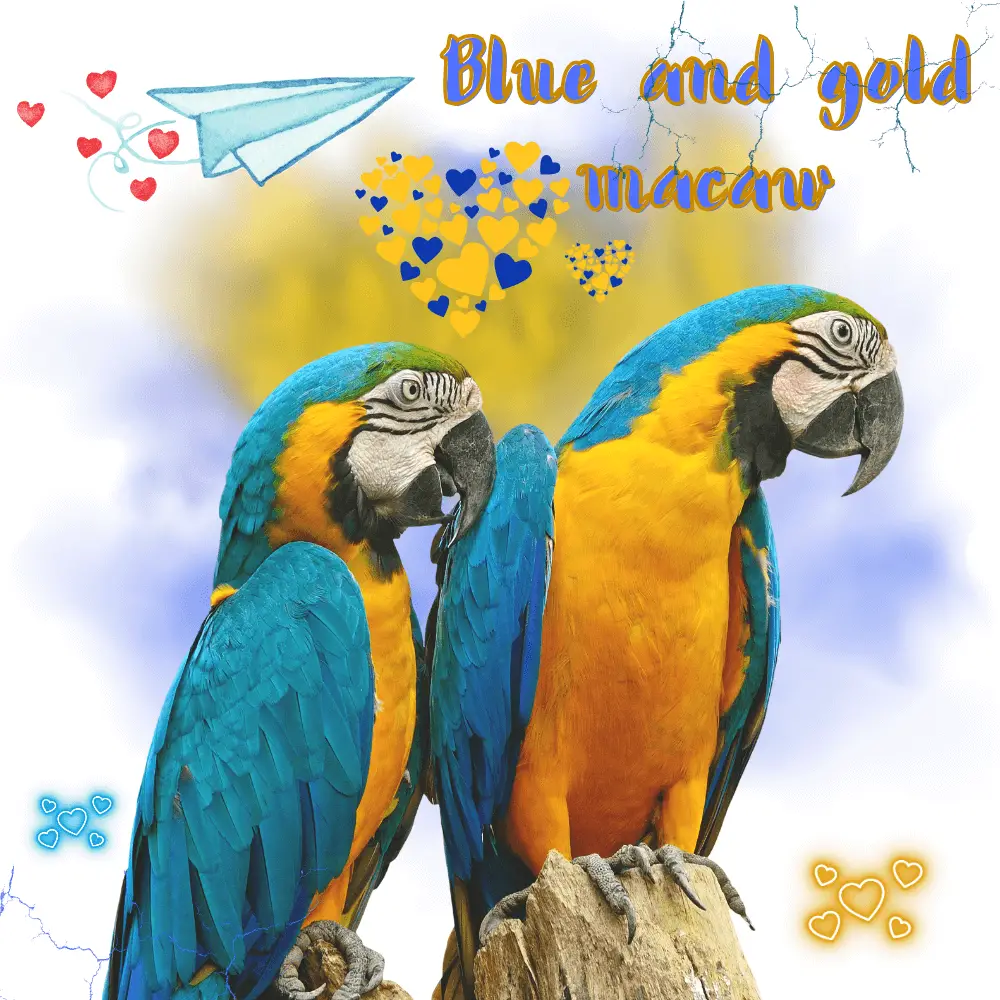The blue and gold macaw (blue and yellow macaw) is one of the most popular parrots. They are instantly recognizable by their vibrant blue and yellow (or gold) plumage and boisterous personalities.
These parrots are among the most popular species of parrots in North America, so they are not hard to find and they won’t cost you nearly as much as some of the other parrots out there.
If you are interested in learning more about the blue and golden macaw, please read on, and you just might learn something new about these adorable birds! I would also like to remind you that if you search for the blue and golden macaw breed, you can find it for sale in the animal section of Used.
Their upper bodies, including their wings, are a brilliant turquoise blue, and the undersides that run up to the sides of their heads are a bright golden yellow.
They also have green foreheads and black under their beaks. Interestingly, they are partially white on their faces which will turn pink when they are excited. Females and males are similar and difficult to distinguish between them.
They have black beaks, which are very large, strong, and very scary, and they use them to crush nuts and climb. Their feet are dark gray with four toes which they use to climb and grip things.
Blue and gold macaw habitat

The blue and gold macaw is native to South and Central America from Panama to Brazil, Paraguay, Bolivia, and Venezuela south to Peru. They usually inhabit forests, usually near water as well as savannas with a few trees and palms as well as forest swamps.
The International Union for Conservation of Nature has placed the blue and golden macaw on its Red List as not under threat, but its species is declining in the wild.
They have been traded to the pet industry heavily since 1981. They have lost a third of their habitat, and at least 60,000 blue and gold macaws have been trapped in the pet trade industry over the past six years.
Blue and gold macaw personality

In the wild, these parrots tend to stay in pairs or small family groups quite high in the trees. But in the early morning and late afternoon, they join large, noisy flocks while feeding. When they fly in pairs, they have been known to fly so close together that their wings touch.
Blue and Gold Macaws have very large personalities to match their vibrant colors. They can be very noisy parrots, but they can also be loving and affectionate with their humans.
These parrots are very social birds that are mild and sweet in nature and will willingly seek attention. They are also very playful and curious, but they can be very sensitive birds.
Blue and gold macaws are very smart and can be taught tricks. They are not shy about showing how they feel. They will fluff their feathers and may scream if they do not want you to come near them. But they’ll also rub their heads at you when you’re in a good mood and give you kisses.
Blue and gold macaws talking
The Blue and Gold Macaw has loud, harsh calls with a variety of squawking-type sounds and is prone to screaming. Once they start screaming, you can’t really stop them, so these birds are definitely not suitable for people in apartments or living in close quarters with others.
Moreover, they are famous for their speaking ability. These intelligent parrots are quick learners and can pick up a vocabulary of about 20 words or so (or more or less, depending on the bird and owner).
SOURCE: African Grey Parrot Pet
Blue and gold macaw care
Other than the macaw itself, a cage for this bird will be one of the most expensive purchases you will need to make. Your parrot should be able to stretch and flap its wings without hitting anything. Given that it has a wingspan of 102 centimeters, the blue and gold macaw will require a large enclosure.
At a minimum, they should be about 8″W x 10″L x 12″H, but bigger is always better. The distance between the bars should be from 2.5 to 3.8 centimeters. You can also consider turning one room in your house into a bird-safe room.
Parrots are notorious chewers, so you will need to provide your bird with several things it can safely chew on items such as pine cones, fir branches, and wood designed for birds. They really enjoy exploring things by taking them apart or breaking them.
You can also purchase toys specifically designed for large parrots and large areas that you can place around your home.
macaws don’t necessarily need to be bathed, so if your parrot doesn’t seem to like it, you don’t need to force it. Otherwise, just make water available to your parrot, and he can fend for himself.
It is not necessary to bring another bird into your home as a companion for your parrot. If you are able to spend a lot of time with your bird, this is usually enough for most parrots.
If you socialize your parrot while it is growing up to be comfortable around other people, birds, or pets, it will be more comfortable around everyone. However, it is not recommended that you allow your parakeet to spend time outside of its cage with a smaller bird without supervision.
Blue and gold macaw health

Some of the more common health issues that blue and gold macaws may be susceptible to are:
- Wasting parrot syndrome
- Beak enlargement feather plucking
- Respiratory infections Kidney and urinary tract disorders
Beak and feather disease Some signs of macaw disease include:
- Breathing problems: Difficulty breathing or making a hoarse voice
- Excessive drooling
- Loss of appetite: Possible weight loss
- Eye problem: Swollen, watery, and/or closed eyes
- Diarrhea
- Weakness: Loss of balance, drooping of wings
- Behavioral changes: Mood swings, lethargy
You know best your bird, so you’ll be able to tell when something is wrong with your pet. Consult your vet if you notice these symptoms.
Blue and gold macaw diet
When in the wild, blue and gold macaws eat a variety of nuts, seeds, and fruits, especially palm tree fruit. As a pet, a parrot’s diet could consist of:
- Nuts: Walnuts, peanuts, and pine
- nuts Fruits: Bananas, oranges, apples, peaches, grapes, papayas, berries, and mangoes.
- Vegetables: sweet potatoes, leafy greens, corn on the cob, zucchini, cucumbers, carrots.
You can give your parrot a pellet diet that contains healthy seeds like chia, flax, and hemp, as well as sprouted or soaked sunflower seeds.
Blue and gold macaw adoption
If you have decided that you would like to invest in a blue and gold macaw as a new pet, be sure to check how a potential macaw was bred and what its history is before you bring it home. They are beautiful to look at and they can make unique, loving companions in the right family.
Related article:

